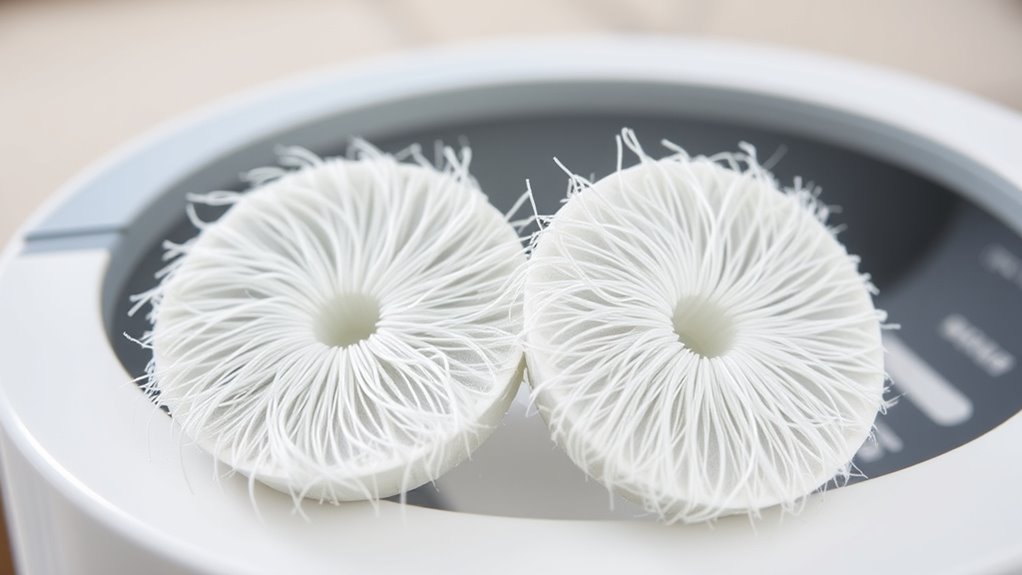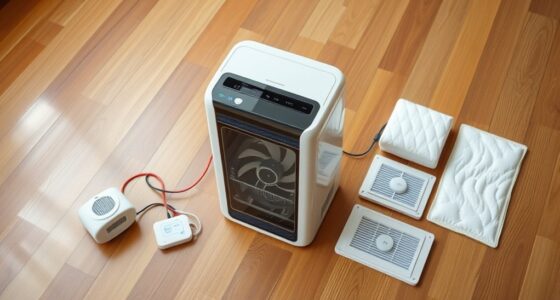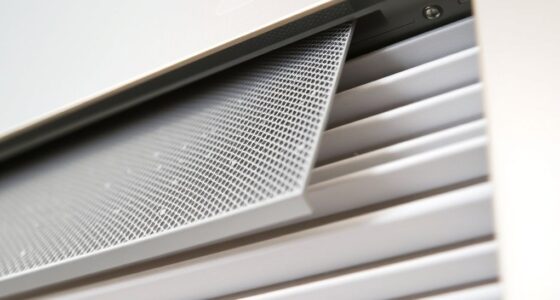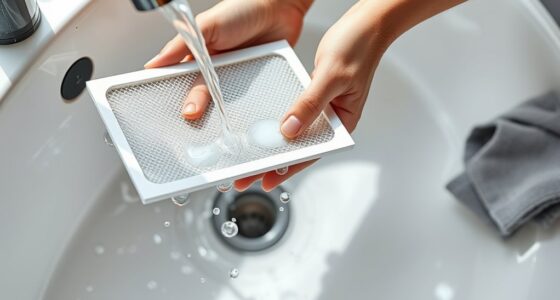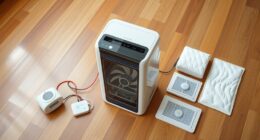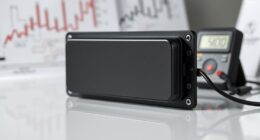You should replace the wick in your evaporative humidifier regularly to keep your air healthy and your device running smoothly. Typically, it’s best to swap it out every 1-3 months, especially if you notice reduced moisture output, mold, or mineral buildup. Hard water areas may require more frequent changes. Proper maintenance prevents mold growth and keeps your humidifier efficient. Keep watching to discover more about the best timing and reasons for wick replacement.
Key Takeaways
- Replace wicks every 1-3 months or as recommended by the manufacturer.
- Indicators include reduced moisture output, mold, mineral buildup, or clogging.
- Hard water accelerates mineral deposits, requiring more frequent wick replacements.
- Using the correct wick material (synthetic or cellulose) enhances performance and longevity.
- Proper maintenance prevents mold, bacteria growth, and ensures optimal humidifier function.
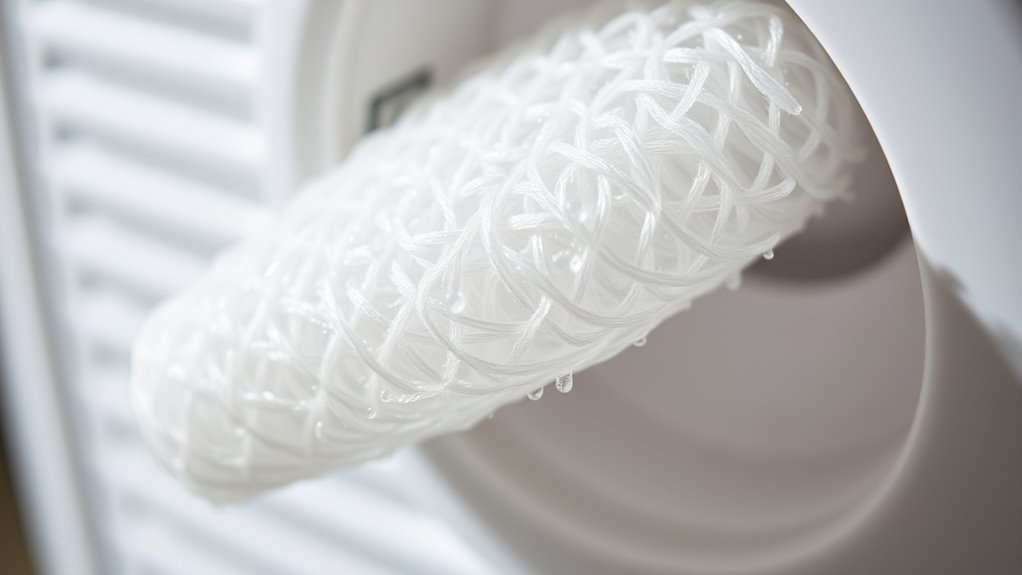
If you own an evaporative humidifier, replacing the wick filter is vital for maintaining ideal performance and air quality. The wick serves as the core component responsible for drawing water from the tank and dispersing moisture into the air. Over time, mineral deposits, mold, and bacteria can accumulate on the wick, reducing its efficiency and potentially releasing contaminants into your indoor environment. Proper humidifier maintenance, including timely wick replacements, ensures your device operates at its best and keeps the air in your home fresh and healthy.
Regularly replacing your evaporative humidifier wick maintains air quality and optimal performance.
Understanding when to replace your wick is important. Generally, you should inspect the wick every month during the peak humidification season. If you notice buildup of mineral deposits, mold spots, or if the humidifier isn’t producing as much moisture as it used to, it’s time for a new wick. Some manufacturers recommend replacing the wick every one to three months, depending on water quality and usage frequency. Hard water, which contains higher mineral content, tends to clog and degrade the wick faster, so regular replacements are especially significant in such cases. Regularly checking and replacing the wick can also prevent the growth of mold and bacteria, which can negatively impact indoor air quality.
Choosing the right wick material for your humidifier is equally significant. Not all wicks are created equal; they come in various materials like cellulose, synthetic fibers, or a combination of both. Cellulose wicks are affordable and effective but tend to retain more minerals and bacteria over time. Synthetic wicks, on the other hand, are more resistant to mold and mineral buildup, offering longer-lasting performance. When selecting a replacement wick, consider your water quality, your device’s specifications, and the manufacturer’s recommendations. Using the correct wick material not only prolongs the lifespan of your humidifier but also enhances humidifier upkeep by reducing the frequency of replacements and cleaning.
Frequently Asked Questions
How Often Should I Replace My Evaporative Humidifier Wick?
You should replace your evaporative humidifier wick every 1 to 3 months to maintain proper humidifier maintenance and guarantee maximum performance. A wick’s lifespan depends on usage, water quality, and cleaning habits. Regularly inspect the wick for signs of mold, mineral buildup, or deterioration. Replacing it on time helps prevent bacteria growth and keeps the humidifier functioning efficiently, providing clean, healthy moist air in your home.
Can I Clean or Reuse Old Wicks Instead of Replacing Them?
You might think you can clean or reuse old wicks, but don’t be fooled—wicks are like tiny sponges that trap bacteria and mineral buildup, making them unsafe after just one use. Cleaning methods like rinsing or scrubbing won’t restore wick longevity or effectiveness. For fresh, healthy mist, it’s best to replace your wicks regularly. Reusing old ones risks mold, bacteria, and poor air quality, so play it safe and swap them out.
Are There Compatible Wicks for All Humidifier Models?
Not all humidifier models use compatible wicks, but many follow wick standardization, making it easier to find replacements. You should check your humidifier’s compatibility before buying new wicks, as some brands and models require specific sizes or designs. To guarantee proper function and avoid damage, always select wicks designed for your humidifier’s make and model, rather than assuming generic options will fit perfectly.
How Do I Know if My Wick Needs Replacing?
Think of your wick as the heart of your humidifier, and it’s telling you when it’s tired. If you notice discoloration or a musty odor wafting from it, that’s your cue to replace. These signs indicate buildup or mold, which can diminish performance and harm your air quality. Trust your senses—when your wick looks or smells off, it’s time for a fresh start to keep your humidifier working smoothly.
What Are the Signs of a Malfunctioning or Ineffective Wick?
You’ll notice a malfunctioning wick if your humidifier produces moisture inconsistency or if you detect unusual odors. When the wick is clogged or moldy, it won’t absorb water properly, leading to uneven humidity levels. Unpleasant smells can also develop due to bacteria or mold buildup. If you observe these signs, it’s time to replace the wick to restore peak performance and maintain fresh, healthy air in your space.
Conclusion
Regularly replacing your humidifier’s wick can boost air quality and extend your device’s lifespan. Did you know that neglecting to change the wick can reduce humidifier efficiency by up to 50%? By staying on top of replacements, you guarantee ideal performance and healthier indoor air. Don’t wait for visible mold or bad odors—change your wick proactively. Keeping your humidifier in top shape benefits your comfort and health, so make wick replacement a routine part of your maintenance.
